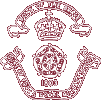| Navigation links at the bottom of this page |
| Solving a mystery of the Western Front |
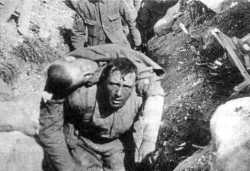 |
Who has not seen a World War One documentary with the film clip of a Tommy carrying a wounded comrade along a trench to a casualty clearing station? This moving image appears again and again on tv footage of the First World War. The identity of the stoical carrier looking into the camera has been a mystery to many a viewer, which has till now defied researchers. The haunting image is one of the horror, tragedy and pathos of warfare. Did the wounded comrade survive? That is an unanswered question, but the identity of the carrier may have at last been discovered.
The most likely candidate who fits the role of the soldier in the film clip carrying a wounded comrade was Herbert Bridgen, son of Gunner Bridgen, who died in 1903 at age 39. |
Image from the Battle of the Somme
fought between
July to November 1916
|
Herbert William Bridgen was born in Portsmouth, Hants, on 26 May 1896, and admitted to the Duke of York's on 30 May 1905. The school was still at that time occupying its Chelsea premises while new faciities were under construction at Dover. The School moved from Chelsea to Dover in 1809, so young Bridgen was among those in the move. He left the school in October 1910 when, at age 14, he volunteered for service in the Royal Horse Artillery (RHA). This meant joining the Boys' Battery of the Regiment at Woolwich. He left the Duke of York's School with an Army Second Class Certificate of education, which gave him a strong advantage over boys enlisting from civilian live. The certificate assured him a good start in military life. He is also thought to have been a proficient bugler. His father, a gunner in the RA, had died in 1903 at the early age of 39. His mother was still living.
|
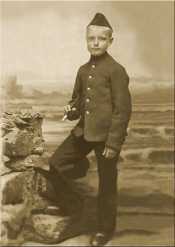 |
Herbert William Bridgen in 1910 at the Duke of York's RM School,,
Chelsea, during his first year, as indicated by the lack of a GC stripe..
|
|
|
 |
|
|
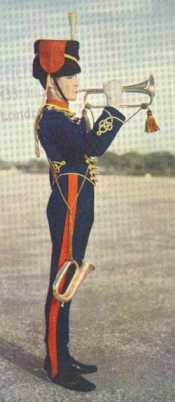 |
As described in an undated recruiting brochure from which the accompaning image is copied, the tradition of boy service in the Royal Horse Artillery dates back to the formation of the Regiment in 1716. It is therefore one of the oldest units of the British Army with a recorded history of boy service. Originally, boys were enlisted directly into normal gunner units as trumpeters. In the case of Boy Bridgen, it is fairly certain that he was already a proficient bugler and trumpeter by the time he joined the RHA because the Duke of York's was renowned for training young musicians who were in high demand in regimental bands throughout the Army. As was the custom before WWI, boys who enlisted in the Boys Battery remained in Woolwich for a year and, after their initial training, were posted to permanent units. |
Trumpeter of the RHA Boys' Battery in ceremonial dress. The image was used on a 1930s brochure in the Central Recruiting Depot, Great Scotland Yard, S.W.1. |
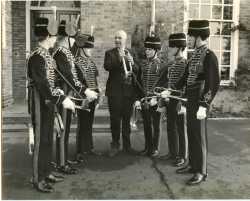 |
Major Dobbs (rtd), a fomer trumpeter from
the 1937 era, visiting with junior trumpeters of the Boys' Brigade of the Royal Artillery, Woolwich (c1977).
|
|
|
The artillery used in the First Battle of the Somme was placed well behind the first and second front line trenches, so what would a gunner be doing at the front at any time? The answer is simple and rational. When, after his first year at Woolwich, Gunner Bridgen was posted to the 76th Battery of the 9th Brigade, RA, he was given driver training. He is indeed identified On his record of service as a driver. Being a driver in the Royal Artillery makes his presence in the front line trenches explicable. During WWI, gun batteries required the services of forward observers, usually commissioned ranks, to direct the fire of the guns. The forward observation officer of 9th Brigade would have the services of a driver to convey him to the front. While he was in the front line waiting around while the forward observer did his work, Driver Bridgen would have made himself useful helping move the wounded to the rear. The difficulty in making documentary identification is that Bridgen, like many who served at the front, never spoke of his wartime experiences. The evidence of his identity comes from his son and grandson, David Bridgen, who supplied the images shown here of his grandfather Herbert whose son recognized him immediately the first time saw the film clip on television. |
|
 |
 |
|
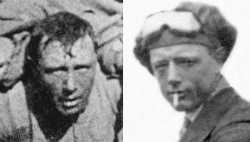 |
Compare these two images, the first taken from the film clip of the man believed to be Gunner Bridgen at the Western Front and, secondly, a head and shoulders enlargement of Herbert taken on an army motorcycle in 1929. His son said that he recognised his father the very first time he saw the shot of a wounded soldier being carried along a front-line trench during the first Battle of the Somme. It was not simply the appearance of the eyes of the carrier facing the camera, which are distinctive, or his characteristic facial expression, but the shape of his hairline. In the son's opinion, there is no question they are one and the same person. There is a remarkable likeness between the two. |
Comparison of two images claimed to be Driver Herbert Bridgen by his descendants. |
|
 |
|
Herbert remained in the Army after the war; naturally, he was a regular soldier and not a conscript, so he still had time to serve. He married in 1930. His marriage certificate records his occupation of driver. He was still in the 76th Battery of the 9th Brigade. There is no evidence that he was promoted to higher rank at this time, which is unusual and most probably explained by the fact he suffered from epilepsy, a condition that might have been mild enough for his superiors to accept, but severe enough to deny him promotion. Family tradition has it that during the Second World War, he spent some time 'laying mines on the beaches of the south coast' of England. It would be unusual for an driver in the Royal Artillery to be a member of a mine-laying squad, which was and is the work of the Royal Engineers. |
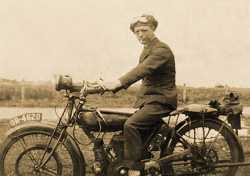 |
Herbert Bridgen seated on an army motorcyle at Milford-on-Sea in 1929 while serving with the 76th Battery, 9th Brigade, RA |
It is possible to that he was co-opted to deliver mines to beach off-loading storage areas, work mistaken by his family for actual mine laying work. The answer to this, however, will never be known. Like his father before him (who died at age 39) Herbert died in 1941 at the early age of 45. Unfortunately, his papers and most of the family photographs were destroyed in a house fire. |
 |
|
|
| |
|
|
 |

